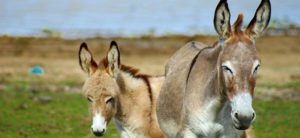Emergency Situation for Donkeys After Industrialization in Brazil
This is an excerpt from an article at plus55.com.
 The story of the Brazilian Northeastern region is intricately linked to the donkey. For centuries, the resilient animal assisted people in their struggle for survival in the poorest and most arid parts of the country. In recent years, though, the situation has changed and the animal appears more as a nuisance than a cultural symbol.
The story of the Brazilian Northeastern region is intricately linked to the donkey. For centuries, the resilient animal assisted people in their struggle for survival in the poorest and most arid parts of the country. In recent years, though, the situation has changed and the animal appears more as a nuisance than a cultural symbol.
Estimates suggest that over the last decade, thousands of animals have been abandoned, often substituted for mechanic labor including tractors, for farming, or motorcycles for transport. The latter saw an expansion from 1.2 million to 6.9 million vehicles between 2003 and 2016 (an increase of 600 percent). Left to themselves, the donkeys have multiplied and are now causing trouble in many states.
One of the few statistics on the subject hints at the size of the problem. Between 2010 and 2013 in just the western part of Rio Grande do Norte state, donkeys caused at least 100 road accidents — and 60 percent were lethal. The Federal Road Police states that the majority of the over 8,000 road accidents involving animals in the northeast over the last four years are related to donkeys.
Many towns are trying to come up with a solution to the overpopulation of donkeys. In July, the state of Bahia approved a bill to regulate the killing of the donkeys; their meat is now sent to feed zoos, and the skin sold to international markets including China. The first 300 animals – the majority of which are captured on state roads – have been sacrificed.
In 2014, state representatives of Rio Grande do Norte contemplated the use of donkey meat to feed inmates and students of the public school system, although the idea was rejected. Other mayors from the Northeast area supported human consumption of the meat, but major obstacles remain with the cultural barrier. People simply don’t want to eat it.
